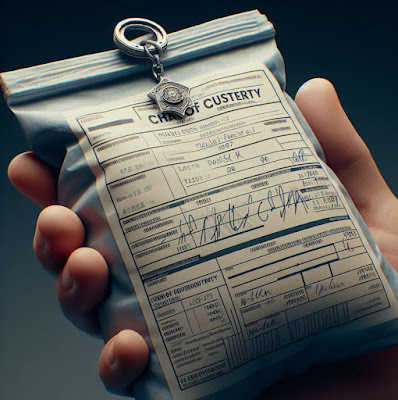Chain of Custody: A Crucial Element in Forensic Science
 |
| Photo By Ai |
In the realm of forensic science, the integrity of evidence is paramount. From crime scenes to courtrooms, the chain of custody serves as the backbone of ensuring the reliability and admissibility of evidence. Let's delve into the significance of this process through a series of bullet points:
-Definition:
The chain of custody refers to the chronological documentation of the handling, transfer, and storage of evidence from its discovery at the crime scene to its presentation in court.
- Preservation of Evidence:
Proper preservation techniques, such as sealing, labeling, and documentation, are employed to maintain the integrity of the evidence. Any alterations, contamination, or tampering could compromise its validity.
- Initial Collection:
Evidence is collected by trained professionals, often forensic technicians or law enforcement officers, using specialized tools and techniques. Each piece of evidence is carefully documented, photographed, and cataloged at the crime scene.
- Packaging and Labeling:
Once collected, evidence is securely packaged in appropriate containers to prevent contamination or damage during transit. Each package is labeled with unique identifiers, including the case number, date, time, and description of the evidence.
- Documentation:
Detailed records are kept at every stage of the chain of custody, including who collected the evidence, when and where it was found, and any individuals who handled or transferred it thereafter. This documentation provides a clear trail of accountability.
- Transfer of Custody:
When evidence changes hands, whether it's from the crime scene to the forensic laboratory or between different forensic analysts, a formal process is followed. Signatures, timestamps, and written acknowledgments are obtained to document the transfer of custody.
- Storage and Security:
Evidence is stored in secure facilities, such as evidence lockers or climate-controlled rooms, to prevent loss, theft, or degradation. Access to these storage areas is restricted to authorized personnel only.
- Analysis and Examination:
Forensic experts conduct thorough examinations of the evidence using scientific techniques, such as DNA analysis, fingerprinting, ballistics testing, and chemical analysis. The results of these examinations are meticulously documented and may be used as evidence in court.
- Chain of Custody Logs:
Throughout the entire process, chain of custody logs are maintained, detailing every movement and handling of the evidence. These logs serve as a comprehensive record that can be presented in court to demonstrate the integrity and reliability of the evidence.
- Admissibility in Court:
Adherence to strict chain of custody protocols is essential for evidence to be deemed admissible in court. Defense attorneys may challenge the validity of evidence if they can cast doubt on its chain of custody, highlighting any discrepancies or gaps in documentation.
- Expert Testimony:
Forensic experts may be called upon to testify in court regarding their findings and the chain of custody process. They must be able to confidently affirm the integrity of the evidence and the reliability of their analysis.
- Legal Implications:
Failure to maintain an unbroken chain of custody can have serious legal ramifications, potentially leading to the exclusion of evidence or even the dismissal of charges. Prosecutors and law enforcement agencies are therefore meticulous in their adherence to chain of custody protocols.
- Continual Monitoring:
The chain of custody doesn't end once evidence is presented in court. It continues to be monitored and documented throughout legal proceedings, ensuring that its integrity is upheld until the case is resolved.
In essence, the chain of custody is the lifeline that ensures the credibility and trustworthiness of forensic evidence in the criminal justice system. By meticulously documenting the handling and transfer of evidence, forensic scientists uphold the principles of integrity, transparency, and accountability, ultimately serving justice and truth.